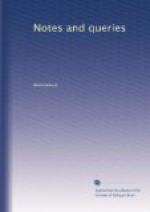JOHN GOUGH NICHOLS
* * * * *
MISCELLANEOUS
NOTES ON BOOKS, SALES, CATALOGUES, ETC.
The Fawkes’s of York in the Sixteenth Century, including Notices of the Early History of Guye Fawkes, the Gunpowder Plot Conspirator, is the title of a small volume written, it is understood, by a well-known and accomplished antiquary resident in that city. The author has brought together his facts in an agreeable manner, and deserves the rare credit of being content to produce a work commensurate with the extent and interest of his subject.
We learn from our able and well-informed contemporary, The Athenaeum that “one curious fact has already arisen out of the proposal for the restoration of Chaucer’s Monument,—which invests with a deeper interest the present undertaking. One of the objections formerly urged against taking steps to restore the perishing memorial of the Father of English Poetry in Poets’ Corner was, that it was not really his tomb, but a monument erected to do honour to his memory a century and a half after his death. An examination, however, of the tomb itself by competent authorities has proved this objection to be unfounded:—inasmuch as there can exist no doubt, we hear, from the difference of workmanship, material, &c., that the altar tomb is the original tomb of Geoffrey Chaucer,—and that instead of Nicholas Brigham having erected an entirely new monument, he only added to that which then existed the overhanging canopy, &c. So that the sympathy of Chaucer’s admirers is now invited to the restoration of what till now was really not known to exist—the original tomb of the Poet,—as well as to the additions made to it by the affectionate remembrance of Nicholas Brigham.”




